Urolithiasis in southern Thailand
Keywords:
urolithiasis, calculi, incidence, componentAbstract
Objective: To address the incidence and epidemiology of urolithiasis in southern Thailand.
Design: Descriptive study
Materials and methods: The incidence of urolithiasis during 1998 - 2002 was analysed from data of the Ministry of Public Health. For epidemiologic study, over one-year period, urolithiasis patients searching for treatment in Songklanagarind Hospital were enrolled, the data of the patients were described. For stone composition study, calculi from operative theater and ESWL Unit (Extracorporeal Shock Wave Lithotripsy) of Songklanagarind Hospital were analysed with infrared spectroscopy
Results: The province with highest incidence of urolithiasis in the South is Satoon in 2002. The common age group is 41-60 year-old, ratio of male to female is 1.5 : 1 and farmer is the most common occupation found in urolithiasis patients. 53.7% of the patients has recurrent stone in 2 years and 42.3% has BMI > 25.0. The diagnosis revealed, 57.4% as renal calculi, 39.1% as ureteric calculi and 3.5% as vesical or urethral calculi. Most of the patients were treated by non-invasive and endoscopic surgery. The most common component for pure stone of upper tract calculi is oxalate, whereas lower tract calculi is uric acid.
Conclusion: The province needed exploration in urolithiasis is Satoon, because of the highest incidence. Most of common age group of urolithiasis patients in southern Thailand is 41-60 year-old, male to female ratio is 1.5 : 1. The most common component for pure stone of upper tract calculi is oxalate, whereas lower tract calculi is uric acid. Common component for mixed stone of upper tract and lower tract calculi are oxalate and phosphate.
References
Gojseni P, Visetsin V, Leungwattanakij S. Urolithiasis. In: Gojseni P, Ratana-Olarn K. Surgery of the urinary system and male genital organs. Bangkok: Siam Stationary Supply Co.Ltd., 1994: 288.
Unakul S. Urinary stones in Thailand; A statistical survey. Siriraj Hospital Gaz 1691; 13: 199-214.
Chaimuangraj S, Leungwattanakij S, Gojaseni P. The current therapy of urinary calculi in Thailand. J Med Assoc Thai 2000; 83:701-7.
Aegukkatajit S. Epidemiology of stone diseases in north-eastern Thailand. In: Urolithiasis: Current status, 17th Academic meeting of the Royal College of Surgeons of Thailand 2003: 1-17.
Soontornpan S. Epidemiology of stone diseases in Chaing Mai University Hospital. In: Urolithiasis: Current status, 17th Academic meeting of the Royal College of Surgeons of Thailand 2003: 18-23.
Pattaravoratam S. Epidemiology of stone diseases in Sawanpracharak Hospital. In: Urolithiasis: Current status, 17th Academic meeting of the Royal College of Surgeons of Thailand 2003: 24-5.
Nualyong C. Epidemiology of stone diseases in Siriraj hospital. In: Urolithiasis: Current status, 17th Academic meeting of the Royal College of Surgeons of Thailand 2003: 26.
Sriboonlue P, Prasongwatana V, Chata K, Tungsanga K. Prevalence of upper urinary tract stone disease in a rural community of north-eastern Thailand. Br J Urol 1992: 240-4.
Menon M, Parulkar B, Drach G. Urinary lithiasis: Etiology, diagnosis, and medical management. In Campbellûs urology 7th ed. WB Saunder company Philadelphia, Pennsylvania 1998; 2665.
Swaddiwudhipong W, Mahasakpan P, Chaovakiratipong C, Nguntra P, Tatip Y, Koonchote S, et.al. Screening assessment of persons 40-59 years of age in rural Thailand by a mobile health unit. J Med Assoc Thai 1999: 82; 131-9.
Lojanapiwat B. Changing incidence and treatment of urolithiasis in Chaing Mai; 4 decades.In: Nephrolithiasis in Thailand. Nobel Print, Bangkok 2002: 169.
Wichai Chaijitkul, Payak Prapinyawongskul, Kangwan Wongratsamedeun, It-Thipol Soongkaeng, Witoon Prasongwatana, et.al. Infrared spectroscopy analysis of urinary tract stone collected from 4 community hospitals in Udorn Thani Province. Srinagarind Hosp Med J 1991; 6: 85-92.
Muangman V. Report of urolithiasis composition in Ramathibodi Hospital during 1988-1989.


